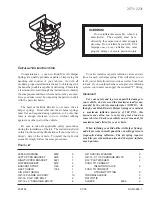
Make sure the differential locks are switched
on at all times except when driving off-road
for example. Switch on the differential locks
immediately when returning from off-road
driving.
ABS
G
Observe Safety notes, see page 50.
G
Warning!
Do not pump the brake pedal. Use firm, steady
brake pedal pressure instead. Pumping the
brake pedal defeats the purpose of the ABS
and significantly reduces braking
effectiveness.
The Antilock Brake System (ABS) regulates
the brake pressure so that the wheels do not
lock during braking. This allows you to
maintain the ability to steer your vehicle.
The ABS is functional above a speed of
approximately 5 mph (8 km/h) independent
of road surface conditions, provided the
differential locks are not engaged.
On slippery road surfaces, the ABS will
respond even to light brake pressure.
The
!
indicator lamp in the instrument
cluster comes on when you switch on the
ignition. It goes out when the engine is
running.
Braking
At the instant one of the wheels is about to
lock up, a slight pulsation can be felt in the
brake pedal, indicating that the ABS is in the
regulating mode.
X
Keep firm and steady pressure on the brake
pedal while you feel the pulsation.
Continuous, steady brake pedal pressure
yields the advantages provided by the ABS,
namely braking power and the ability to steer
the vehicle.
The pulsating brake pedal can be an
indication of hazardous road conditions and
functions as a reminder to take extra care
while driving.
Emergency brake maneuver
X
Keep continuous full pressure on the brake
pedal.
G
Warning!
If the ABS malfunctions, other driving safety
systems such as the BAS or the ESP
®
are also
switched off. Observe indicator and warning
lamps that may come on as well as messages
in the multifunction display that may appear.
If the ABS malfunctions, the wheels may lock
during hard braking, reducing steering
capability and extending the braking distance.
LOW-RANGE ABS
During off-road driving, a special low-range
system for the ABS is operational with the
transfer case in position LOW (
Y
page 91).
An improved braking action (dig-in effect) is
obtained for vehicles speeds of up to 37 mph
(60 km/h) through a change in the ABS
control function.
BAS
G
Observe Safety notes, see page 50.
The Brake Assist System (BAS) operates in
emergency situations. If you apply the brakes
very quickly, the BAS automatically provides
full brake boost, thereby potentially reducing
the braking distance.
X
Apply continuous full braking pressure until
the emergency braking situation is over.
The ABS will prevent the wheels from
locking.
When you release the brake pedal, the brakes
function again as normal. The BAS is then
deactivated.
G
Warning!
If the BAS malfunctions, the brake system still
functions, but without the additional brake
Driving safety systems
51
Safety and security
463_AKB; 2; 52, en-US
d2ureepe,
Version: 2.11.7.1
2008-12-02T10:52:11+01:00 - Seite 51
Z
Содержание 2009 G 55 AMG
Страница 4: ...463_AKB 2 52 en US d2ureepe Version 2 11 7 1 2008 12 02T10 52 11 01 00 Seite 2 ...
Страница 58: ...56 463_AKB 2 52 en US d2ureepe Version 2 11 7 1 2008 12 02T10 52 11 01 00 Seite 56 ...
Страница 260: ...258 463_AKB 2 52 en US d2ureepe Version 2 11 7 1 2008 12 02T10 52 11 01 00 Seite 258 ...
Страница 261: ...259 463_AKB 2 52 en US d2ureepe Version 2 11 7 1 2008 12 02T10 52 11 01 00 Seite 259 ...
Страница 262: ...260 463_AKB 2 52 en US d2ureepe Version 2 11 7 1 2008 12 02T10 52 11 01 00 Seite 260 ...
















































